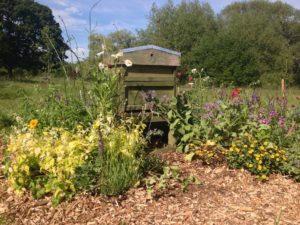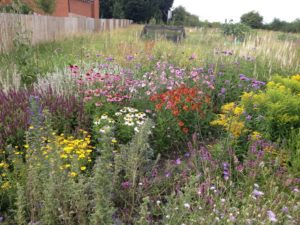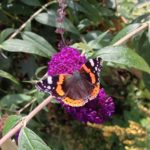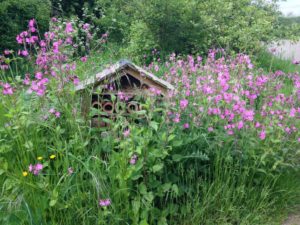
Pollinators are struggling in the UK and we need to give them a hand. We rely on them for a lot of our food production and for pollinating many of our garden plants. Much of the green space in Wantage is dominated by close-cut grass that offers very little of value to pollinators, or any other wildlife for that matter. Areas can still be cut short for paths and to play sports, but there are plenty of spaces that can be left to support wildlife too.
We can improve the situation in some very simple ways that also save money and reduce carbon emissions – that’s got to be a win-win!
What can I do to help?
1. Add some plants for pollinators in your garden. There is a huge range of attractive plants that are also great at attracting bees, butterflies and other pollinators, and help support their populations. Great advice here Plants for Pollinators (RHS)

2. Create a wild patch in your lawn – you might be surprised to see what appears amongst the grass. Often plants we consider weeds provide great nectar and pollen for many insects. For step-by-step advice, go here Grow a Wild Patch (BBOWT)
3. Add some flowering shrubs or trees to your garden – Hawthorn, Buddleia, fruit trees, Pussy Willow, Californian Lilac will all soon be buzzing with life 20 Flowering Shrubs for Bees (BuzzAboutBees)

4. Leave that ivy! Contrary to what many people think, ivy does not strangle trees (it only grows into the crown when trees are already struggling) and can be a great source of late pollen, nectar and fruit for many species, at a time when little else is about. Tolerate ivy where you can and the wildlife will love you for it.
5. Lets improve our verges and community green space. So much of our green space is short-cut grass which is of very little use to wildlife and pretty boring to look at:
- Cut it less and let the dandelions and other wildflowers grow
- Add some spring bulbs like snowdrops, daffodils or crocuses
- Add the attractive yellow rattle; this will weaken the grass and let other flowers get going
- Take on the management of your verge and ask the Council to stop cutting it. Probably best to add a sign too that reminds them not to cut it and shows someone is looking after it.
- Plantlife are leading a great campaign here Road Verge Campaign.

6. Add a bee or butterfly house in your garden – this will help them survive the winter or give them somewhere to lay eggs for next year’s brood. You don’t need to buy one, there are lots you can make Design a Bug Hotel (Urban Gardens)
Did you know many wildflowers, when left to seed, provide food for birds such as goldfinches that will come down and pick out the seeds even from tiny dandelion heads.
Many bees and other insects will lay eggs in the hollow stems so leave them in place until late spring.
Back to The Mix main page.
Wild Wantage images ©Mark Bradfield / Lucy Duerdoth

